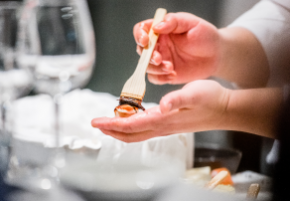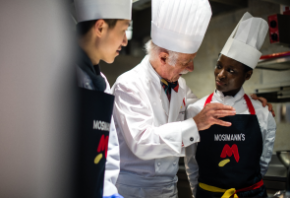- About
- Programs
- Campus Life
- Career Services
- Admissions
- News & Events
- Alumni
Food Cost Percentage Formula: Reduce Waste, Increase Profit
Master the food cost percentage formula with our detailed guide. Learn how to calculate food costs, set the right menu prices & avoid common pricing mistakes.
Key Takeaways
- Carefully tracking your food cost percentage helps you price menu items, track profitability, and control waste.
- Using the food cost percentage formula at home might sound unusual, but it can be a smart way to budget and plan meals more efficiently.
- Forgetting hidden costs, miscalculating portion sizes, ignoring spoilage and waste, and relying on outdated prices are common mistakes when calculating food cost percentages.
Knowing your food cost percentage is essential for running a successful restaurant or food business. It shows how much of your revenue goes toward ingredients, helping you set strategic menu prices and protect your profit margins. When you understand the food cost percentage formula, you can manage your kitchen more efficiently, minimize waste, and make smarter operational decisions.
Food cost percentage also connects directly to your inventory management, supplier selection, and even your team's portion control. Today, tools like point-of-sale systems and inventory tracking software make it easier than ever to calculate and monitor food costs without spending hours doing math.
What Is the Formula Used to Calculate a Food Cost Percentage?
Food cost percentage shows how much of your sales income is spent on the ingredients used to prepare your food. It is a critical number for pricing your menu and understanding your profit margins. If your food cost percentage is too high, it can significantly impact your business.
The formula for calculating food cost percentage is:
(Cost of Goods Sold ÷ Food Sales) × 100
Let's break that down:
- Cost of Goods Sold (COGS) is the total amount spent on food ingredients over a period. For example, if you spent $2,000 on food in one week, that's your COGS.
- Food sales represent the revenue earned from selling food during that same period. If your food sales totaled $6,000, you would plug that into the formula:
($2,000 ÷ $6,000) × 100 = 33.3% food cost percentage
This means one-third of your food sales went into purchasing ingredients.
How to Use the Food Cost Percentage Formula
You can use the food cost percentage formula to price menu items, track profitability, and control waste. It works in restaurants, catering services, food trucks, and even hotel kitchens. By using it regularly, managers can spot trends, adjust portions, and make smarter buying decisions that keep their business healthy and efficient.
Basic calculation for a restaurant
Imagine a small restaurant wanting to calculate its food cost percentage over the course of a month. The total amount spent on ingredients during that specific month was $12,000. The total food sales reached $36,000.
Using the formula:
($12,000 ÷ $36,000) × 100 = 33.3%
This means that for every dollar the restaurant earned from food sales, about 33 cents went toward ingredient costs.
Knowing this percentage helps the restaurant evaluate whether they're pricing dishes correctly or overspending on supplies. If the percentage is too high, they might reduce portion sizes, renegotiate with suppliers, or tweak recipes to include more cost-effective ingredients.
If it's too low, they might be underserving customers or overpricing dishes. Regular calculations like this help restaurants balance quality and cost, allowing them to make better financial decisions.
Weekly calculation for a café
Cafés often track their food cost percentage weekly to stay on top of fast-moving items like pastries, milk, and coffee.
For example, if a café spends $1,200 on ingredients in one week and earns $4,000 in food and drink sales, the calculation would be:
($1,200 ÷ $4,000) × 100 = 30%
This means 30 percent of the café's weekly sales went toward ingredients.
Tracking weekly helps spot trends early and allows them to respond quickly to rising costs or shifts in customer habits. For example, if milk prices rise and suddenly the cost jumps to $1,500 the next week, the café knows to raise drink prices or adjust recipes before profits drop. It also helps manage waste more effectively, ensuring ingredients are used before expiration. Such small, regular adjustments keep the café efficient and profitable over time.
Food truck scenario
Food trucks face unique challenges like limited storage, fluctuating ingredient costs, and unpredictable daily sales based on location or weather. Because of this, many food truck owners track food cost percentages daily or after each major event.
Let's say a food truck spends $600 on ingredients for a two-day event and earns $1,500 in food sales.
Using the formula:
($600 ÷ $1,500) × 100 = 40%
This means 40 percent of the sales went directly into food costs.
A food cost percentage this high signals the need for a closer look. Maybe certain dishes are too expensive to make, or there's too much waste happening in prep. With this information, the food truck can adjust portions, change pricing, or make menu changes. Small improvements like these can make a big difference in a food truck's tight operating margins and help keep profits from slipping away unnoticed.
Home cooking calculations
Using the food cost percentage formula at home might sound unusual, but it can be a smart way to budget and plan meals more efficiently. Home cooks can track what they spend on ingredients compared to what a similar meal would cost from a restaurant or takeout.
For example, if you spend $18 on groceries to make four portions of pasta, and each portion would cost $12 at a restaurant, your food cost percentage is:
($18 ÷ $48) × 100 = 37.5%
This means you're spending less than 40 percent of what takeout would cost, and you're likely getting healthier portions, too.
Using this formula at home helps families plan affordable meals, cut down on waste, and see real savings over time. Even though you're not running a business, it's a clear reminder of how much restaurants mark up their food and how much you can save by cooking smart.
What Is a Good Food Cost Percentage?
A good food cost percentage varies based on the type of food business. For restaurants, an ideal food cost percentage typically falls between 28-35%. For cafés, food costs tend to be higher, with benchmarks ranging from 30-35%.
These benchmarks can shift depending on factors like location, menu type, and business model. For instance, upscale restaurants may have higher food costs due to premium ingredients, while fast-casual eateries tend to keep costs lower due to simpler, less expensive dishes. Food trucks, with their smaller scale and lower overhead, can also achieve lower food cost percentages compared to traditional restaurants.
At home, food expenses typically make up a portion of a household's total budget. Shopping habits, such as purchasing in bulk, choosing seasonal produce, or reducing dining out, can have a significant impact on these costs.
How to Set Menu Prices Based on Food Cost Percentage
Setting menu prices based on food cost percentage and matching your pricing to ingredient costs is key to keeping your business profitable. To figure out the right price, you can use a simple formula:
Menu Price = (Food Cost / Desired Food Cost Percentage) × 100
For example, if the food cost of a dish is $4 and you want to maintain a 30% food cost, the price would be:
Menu Price = ($4 / 0.30) = $13.33
Practical pricing strategies to consider include:
- Markup pricing: Multiply the food cost by a factor (e.g., 3x) to determine the menu price.
- Tiered pricing: Use lower food cost percentages for high-demand items and higher percentages for specialty dishes.
- Psychological pricing: Set prices just below whole numbers (e.g., $14.99 instead of $15) to appear more attractive.
Alternative Formulas for Food Cost Calculation
There are several variations of the food cost formula to account for different factors affecting your bottom line:
Per Dish Food Cost Formula
This formula is ideal when you want to calculate the ingredient cost for each individual dish. It's helpful for menu pricing and evaluating the profitability of specific items.
Formula:
Per Dish Food Cost = Ingredient Cost per Dish / Menu Price
Example:
If the ingredients for a dish cost $4 and you sell it for $15, the per dish food cost would be:
$4 / $15 = 0.27, or 27%.
Waste & Spoilage Adjustment Formula
This formula helps account for food loss due to spoilage, waste, or over-preparation. It's important for businesses looking to manage inventory effectively.
Formula:
Adjusted Food Cost = (Total Food Cost + Waste Costs) / Total Menu Sales
Example:
If your monthly food cost is $2,000, you estimate waste and spoilage at $300, and total sales are $10,000, the adjusted food cost would be:
($2,000 + $300) / $10,000 = 0.23, or 23%.
Food Cost with Discounts Formula
This formula is useful when you offer promotions or discounts and want to assess how they impact the food cost.
Formula:
Food Cost with Discount = (Ingredient Cost per Dish × Discount Percentage) / Menu Price
Example:
If a dish costs $5 to make, is normally priced at $20, and you offer a 10% discount, the food cost with the discount would be:
($5 × 0.10) / $20 = 0.025, or 2.5%.
These variations help you tailor food cost calculations to specific needs, ensuring your pricing remains profitable even when factors like waste or discounts come into play.
Benefits of Calculating Food Cost Percentages
Calculating food cost percentages offers several important benefits for businesses, including:
- Better pricing: It helps set accurate menu prices based on ingredient costs, ensuring you cover expenses while remaining competitive. Chipotle, for example, adjusted its menu prices by 2% nationwide in December 2024 to help manage rising ingredient costs caused by inflation.
- Waste reduction: Identifying food cost percentages helps businesses track waste and adjust portion sizes or inventory management. Through its "Pret Charity Run","Pret A Manger" achieves food waste of just 2.8%, significantly lower than the UK average of around 30%, by donating unsold food to food rescue organizations at the end of each day.
- Improved profitability: Regular food cost analysis highlights opportunities to improve margins and fine-tune the menu. In-N-Out Burger, for example, uses food cost analysis to keep its menu simple and streamlined, ensuring every item is profitable while maintaining high-quality ingredients at a lower cost.
- Better budgeting and forecasting: Accurate calculations allow for more effective budgeting and sales forecasting. Starbucks, in this case, uses detailed food cost tracking and forecasting to manage inventory and adjust pricing during seasonal changes, ensuring they can meet demand while keeping margins healthy.
Common Mistakes When Calculating Food Cost Percentage
Calculating food cost percentage is crucial for profitability, but there are a few common mistakes that can throw off your numbers. Some pitfalls to watch out for include:
- Forgetting hidden costs: Costs like packaging, condiments, and utilities can be easily overlooked. Always factor in every cost that contributes to making a dish, not just the ingredients.
- Miscalculating portion sizes: Serving sizes can vary, leading to inconsistent food costs. Use a kitchen scale or standardized scoops to ensure portion sizes are consistent.
- Ignoring spoilage and waste: If you don't account for food waste, your food cost percentage will be misleading. Track waste regularly and adjust inventory practices to minimize losses.
- Relying on outdated prices: Ingredient prices change, but some businesses fail to update their cost calculations regularly. Be sure to check supplier prices and adjust your menu prices accordingly.
Beyond the Equation: Master the Food Cost Percentage Formula
Keeping a close eye on food costs is essential to running a successful food business. Whether it's adjusting prices, managing waste, or making sure portions are spot on, staying on top of your food cost percentage is a game-changer for profitability.
If you're serious about mastering this skill, consider exploring Culinary Arts Academy Switzerland (CAAS). Our MA in Culinary Business Management offers a powerful combination of advanced culinary training and business management skills—ideal for anyone ready to take their food business expertise to the next level.
It's all about building skills, making smart adjustments, and steadily improving—much like refining a favorite recipe over time!
Frequently Asked Questions (FAQs)
What is the ideal food cost ratio?
The ideal food cost ratio typically falls between 28-35% for restaurants, depending on the business type and menu.
What is the formula for food cost profit margin?
The food cost profit margin is calculated by subtracting the food cost from the menu price, then dividing it by the menu price, giving you the percentage of profit after covering food costs. Otherwise known as: Profit Margin = (Menu Price - Food Cost) / Menu Price × 100.
What is the formula for labor cost per meal?
To find the labor cost per meal, divide your total labor costs by the number of meals served, helping you understand labor expenses for each dish. In other terms, Labor Cost per Meal = Total Labor Costs / Total Number of Meals Served.
Interested in studying at CAAS? Download our brochure to learn about our programs!























